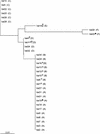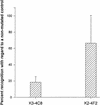Molecular characterization of hepatitis a virus isolates from a transcontinental shellfish-borne outbreak
- PMID: 12409389
- PMCID: PMC139673
- DOI: 10.1128/JCM.40.11.4148-4155.2002
Molecular characterization of hepatitis a virus isolates from a transcontinental shellfish-borne outbreak
Abstract
One hundred eighty-four serologically confirmed cases of hepatitis A were reported in eastern Spain in 1999. A matched case-control study implicated imported coquina clams complying with European Union shellfish standards as the source of infection; this implication was confirmed by the detection by reverse transcription-PCR of hepatitis A virus (HAV) RNA in shellfish samples. In spite of the recognized low variability of HAV, genetic characterization of the complete capsid region of virus isolates from patient serum samples revealed the existence of both synonymous and nonsynonymous variants. Two antigenic variants were detected, one in a discontinuous epitope defined by monoclonal antibody K3-4C8 and a second in a linear VP1 epitope of the virus. In spite of these antigenic variants, all isolates were assigned to genotype IB, providing further evidence that the outbreak originated from a common source, although multiple strains were likely to be involved.
Figures






References
-
- Anonymous. Council directive of 15th of July, 1991. 91/492/EEC. J. Eur. Commun. L268:1-14.
-
- Bosch, A., F. X. Abad, R. Gajardo, and R. M. Pintó. 1994. Should shellfish be purified before public consumption? Lancet 344:1024-1025. - PubMed
-
- Bosch, A., J. F. González-Dankaart, I. Haro, R. Gajardo, J. A. Pérez, and R. M. Pintó. 1998. A new continuous epitope of hepatitis A virus. J. Med. Virol. 54:95-102. - PubMed
Publication types
MeSH terms
Substances
LinkOut - more resources
Full Text Sources
Other Literature Sources
Medical

